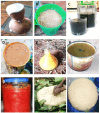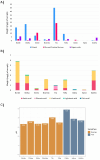Microbial ecology of selected traditional Ethiopian fermented products
- PMID: 40529576
- PMCID: PMC12171217
- DOI: 10.3389/fmicb.2025.1570914
Microbial ecology of selected traditional Ethiopian fermented products
Abstract
The consumption of traditional fermented foods and beverages plays an important role in the diet of Ethiopia, providing significant nutritional and health benefits to the local population. The present study aimed to investigate the microbial ecology and diversity of nine types of fermented products. These include two foods (Kotcho and Injera), one food condiment (Datta), and six beverages (Tej, Tella, Cheka, Kinito, Borde, and Shamita). A combination of metataxonomic and culturomic approaches was used to achieve a comprehensive characterization of the bacterial communities, together with a thorough physicochemical characterization of the fermented products. This study provides one of the most comprehensive microbial characterizations of a wide selection of Ethiopian fermented products, highlighting that some bacterial species involved in the fermentation processes could contribute to the safety and nutritional quality of fermented foods and, based on previous studies, could also play a key role in enhancing their potential probiotic properties.
Keywords: Ethiopian fermented products; culturomics; metataxonomics; microbial ecology; traditional fermented foods and beverages.
Copyright © 2025 Sanz-López, Amato, Torrent, Borrego, Anza, Bibiso, Grijalva-Vallejos, Vilanova, Porcar and Pascual.
Conflict of interest statement
The authors declare that the research was conducted without any commercial or financial relationships that could be construed as a potential conflict of interest. The author(s) declared that they were an editorial board member of Frontiers, at the time of submission. This had no impact on the peer review process and the final decision.
Figures






Similar articles
-
A review on the microbiology of Ethiopian traditional fermented beverage products.Front Nutr. 2025 Jan 29;12:1519547. doi: 10.3389/fnut.2025.1519547. eCollection 2025. Front Nutr. 2025. PMID: 39980675 Free PMC article. Review.
-
Fermented Fruits, Vegetables, and Legumes in Metabolic Syndrome: From Traditional Use to Functional Foods and Medical Applications.Nutrients. 2025 Jun 12;17(12):1989. doi: 10.3390/nu17121989. Nutrients. 2025. PMID: 40573100 Free PMC article. Review.
-
Surveillance for Violent Deaths - National Violent Death Reporting System, 50 States, the District of Columbia, and Puerto Rico, 2022.MMWR Surveill Summ. 2025 Jun 12;74(5):1-42. doi: 10.15585/mmwr.ss7405a1. MMWR Surveill Summ. 2025. PMID: 40493548 Free PMC article.
-
Cereal- and Fruit-Based Ethiopian Traditional Fermented Alcoholic Beverages.Foods. 2020 Dec 1;9(12):1781. doi: 10.3390/foods9121781. Foods. 2020. PMID: 33271792 Free PMC article. Review.
-
Assessing the comparative effects of interventions in COPD: a tutorial on network meta-analysis for clinicians.Respir Res. 2024 Dec 21;25(1):438. doi: 10.1186/s12931-024-03056-x. Respir Res. 2024. PMID: 39709425 Free PMC article. Review.
References
-
- Abegaz K. (2007). Isolation, characterization and identification of lactic acid bacteria involved in traditional fermentation of Borde, an Ethiopian cereal beverage. Afr. J. Biotechnol. 6, 1465–1472.
-
- Abegaz K., Beyene F., Langsrud T., Narvhus J. A. (2002). Parameters of processing and microbial changes during fermentation of Borde, a traditional Ethiopian beverage. J. Food Technol. Africa 7, 85–92. doi: 10.4314/jfta.v7i3.19238 - DOI
-
- Akalu N., Assefa F., Dessalegn A. (2017). In vitro evaluation of lactic acid bacteria isolated from traditional fermented Shamita and Kocho for their desirable characteristics as probiotics. Afr. J. Biotechnol. 16, 594–606. doi: 10.5897/AJB2016.15307 - DOI
-
- Al-Yami A. M., Al-Mousa A. T., Al-Otaibi S. A., Khalifa A. Y. (2022). Lactobacillus species as probiotics: isolation sources and health benefits. J. Pure Appl. Microbiol. 16, 2270–2291. doi: 10.22207/JPAM.16.4.19 - DOI
LinkOut - more resources
Full Text Sources

